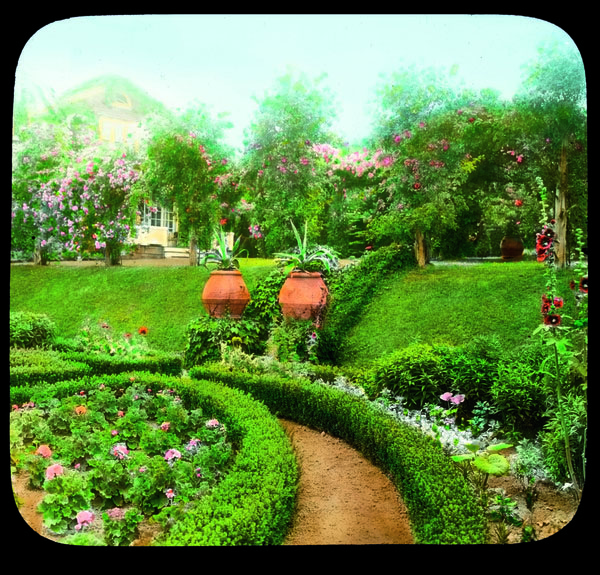
It’s no secret that Hamptons gardens are considered some of the most beautiful in the world. But most probably don’t know that the East End, Southampton Village in particular, was actually critical in the Garden Beautiful movement started by the Garden Club of America, and led by the Southampton Garden Club in the early 1900s.
The Garden Club of America was founded in 1913, and the Southampton Garden Club was one of the first in the nation, according to Sam Watters, the author of “Gardens for a Beautiful America, 1895-1935, Photographs by Frances Benjamin Johnston.” His 400-page book contains a collection of approximately 250 hand-colored, glass-plate lantern slides taken by Ms. Johnston over the span of 40 years.
The slides, many of which were taken on the East End, were unearthed by Mr. Watters at the Library of Congress in Washington, D.C. over a period of painstaking research that took more than five years and hundreds of library visits. His book, published by Acanthus Press, is a collaborative effort between himself and the Library of Congress—the repository of Ms. Johnston’s personal papers and some 20,000 total photographs—which is now exhibiting a collection of more than 1,000 of Ms. Johnston’s images found and researched by Mr. Watters.
“I’m a big believer in public libraries,” he said during a telephone interview last month. “We used this collection as a model for a new kind of cataloging adventure to educate people about the gardens.”
The architectural historian and author of “Houses of Los Angeles, 1885-1919,” “Dream House: The White House as an American Home” and “American Gardens, 1890-1930: Northeast, Mid-atlantic, And Midwest Regions,” among others, said that he found Ms. Johnston (born January 15, 1864 and died May 16, 1952) fascinating.
“Johnston, an architecture photographer famous for some very iconic images of schools after the Civil War, began a new career photographing gardens when she was about 50 years old,” he explained. “She was born one year after the Civil War and died around the time we bombed Nagasaki. She’s an interesting person because she is kind of a ‘new woman’ able to enter the workforce. Photography becomes something available to women—and she, like her mother and her aunt, already working, became a journalist and photographer.”
Mr. Watters, who spent his childhood coming out to the Hamptons (“I know the territory well,” he said.) and whose mother still owns a home in Westhampton, explained that it was actually here on the East End where Ms. Johnston added a new type of photography to her resume.
“She gets her launch into the garden photography world because of the Southampton Garden Club, which as part of the Garden Club of America, launched a campaign to photograph the gardens of members; a how to do a ‘good-taste garden.’”
He added that at the time, Georgina Gertrude Boardman, née Bonner, a member of the Southampton Garden Club, recruited members of her club and of the East Hampton Garden Club to participate by having their gardens photographed by Ms. Johnston. Her home, “Millefiori,” on Great Plains Road and Coopers Neck Lane in Southampton, was photographed in the summer of 1914. The house and gardens, also known as “Villa Mille Fiori” are no longer in existence today but the images survived and are in Mr. Watters’s book.
Earlier this month, current Southampton Garden Club President Lydia Wallis weighed in on Mr. Watters’s preservation efforts via “Gardens for a Beautiful America.”
“It is comforting to know that these slides are not lost forever and are archived at The Library of Congress and now documented in this book to be shared by future generations,” she wrote in an email to The Press. “So often, historical photos are damaged or lost forever. I’m sure the garden club will be as anxious as I to see Sam Watters’s book.”
“The Hamptons is the perfect place because this is where she [Ms. Johnston] got her start with garden photography,” Mr. Watters said. “The most important part is that she starts there. It’s where the estate world was being built—an explosion of building of houses by rich people; most of which are just two and three years old at the time of the photographs.”
East End images in the book include East Hampton’s Grey Gardens—the former home of Big and Little Edie Beale, memorialized in the 1975 film “Grey Gardens” by Albert and David Maysle and now owned by Ben Bradlee and Sally Quinn—but photographed by Ms. Johnston in 1914 when it was the Robert Carmer Hill House. Other Hamptons images in the book include “Snow House,” the home of Frederick Augustus in Southampton, taken in 1914, and “The Stepingstones,” the Anne May Hegeman House and its sunken garden in Southampton, taken in 1915.
Mr. Watters said that historic East End abounds in beauty. That era of time in the early 20th century was magical, he said, and continues to captivate his interest.
“You inevitably end up in the East End if you’re interested in that period; this culture that I’m interested in,” said Mr. Watters. “The culture that produced this world, the good-taste world, where the wealth, the garden building and the architecture were ... I plan on coming back at it. I’ll be back.”